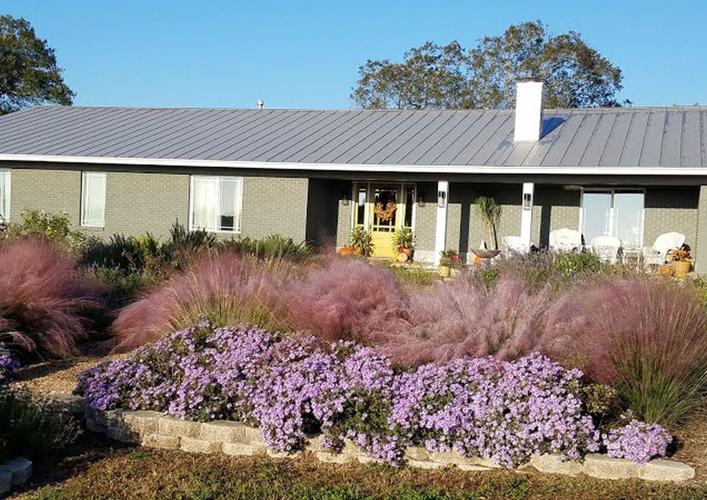You do not have to leave the local area to enjoy autumn color.
People often associate fall vegetative color with maple trees and visits to the Northeastern United States, but trees are not the only plants that put on a fall show.
Fall blooms abound
If you look, you will find a large number of local plants that put on quite a fall display.
- Fall aster
Probably the plant that puts on the best fall display is the fall aster (Symphyotrichum oblongifolium). This perennial is very hardy and easy to grow.
According to Skip Richter writing in the Texas Gardener magazine, the fall aster likes well-drained soil and dislikes fertilizer and overwatering. My kind of plant, it forms a mound about 2 feet high and wide and in mid- to late October it is covered with lavender flowers. The showy display lasts for weeks.
- Spider lilies
Often popping up as a surprise, spider lilies bloom before the leaves appear. They pop up after the first good rain of the fall season.
The most common color is red, but the Victoria Educational Gardens has a yellow variety that is very showy. According to Wikipedia, the spider lily also is available in orange, white and pink. Again, this is a low-Maintenance plant that is invisible for most of the year.
- Mexican bush sage
Another plant that is low-maintenance but a strong fall bloomer is Mexican bush sage (Salvia leucantha). This mounding plant will put up strong flower spikes that can be 3 or more feet long.
I have two different types in my garden. One type sports a purple calyx with a protruding white center flower, while another variety has both purple calyx and purple flower. The plant needs to be cut back each spring and the clumps can spread 4 to 5 feet.
- Copper canyon daisy
Yet another fall bloomer that is low-maintenance is the copper canyon daisy (Tagetes lemonii). According to Richter, these tough perennials grow to 3 or 4 feet tall and are covered with bright yellow flowers in the fall. It is a perennial and is considered deer-proof.
Grasses
One of my favorite plants happens to be a native called Gulf Muhly grass (Muhlenbergia capillaris).
- Gulf Muhly grass
The bright pink seed heads that magically pop out of the thin grass shaft in the fall are amazing. The clump grows to about 3 feet tall, and the plant can be used as a specimen plant or in mass plantings, which I prefer.
Watching the sun rise behind the grass on foggy, fall mornings is almost a magical experience. The grass is very low maintenance, and I use my electric hedge trimmer to whack it back in early spring. It will come up from seeds but is easy to control.
- King Ranch bluestem
A grass with a similar appearance (but not nearly as desirable) is King Ranch bluestem (Bothriochloa ischaemum var. songarica). If you have been driving along the highways recently, you will have noticed a grass along the roadside with pink seed heads that look like ocean waves undulating in the wind. It is known to be invasive, so be cautious bringing it into your garden.
Small trees
- Confederate rose
With blossoms 4 to 6 inches wide, the Confederate rose (Hibiscus mutabilis) is an old favorite in the Southern part of the United States. The blooms open up light pink or white in the morning and the color deepens to a deep pink or red as the day progresses (hence mutabilis). They may freeze back during a good cold snap, but they will sprout again from the roots.
The Confederate rose is easy to propagate from cuttings taken at most any time of the year. According to The Grumpy Gardener writing in Southern Living magazine, this plant likes full to part sun and moist, fertile soil.
- Popcorn plant
Another old-fashioned favorite is the popcorn plant (Cassia bicapsularis). I got my original plant from a local nursery many years ago and have enjoyed it (or one of its offspring) for many years. The popcorn plant blooms are bright yellow and open in early October. My plants have stayed under 8 feet tall, but the University of Florida Extension says they may grow to 12 feet. This non-native plant comes up readily from seed and is easy to transplant. While not invasive, it does tend to pop up, so you have to watch for it.
Fall is here
With a long growing season, many of our plants bloom spring to fall. There are those, however, that are fall accent bloomers when the days get shorter and cooler.










